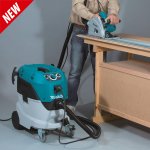I’ve seen photos of this but thought it was only available in Japan, great to see a North American version with bluetooth.
Nilfisk must really have an aggressive rebranding program (aka private labeling team) for the Attix 33/44 line. Milwaukee, Makita, Flex, Mirka, and who knows how many others or others to come. Since FLEX offers a few accessories Nilfisk doesn’t, as well as hose design change, like you say it will be interesting to see what options Makita offers.
(I would be curious to know if [member=69760]Lincoln[/member] has experience with the Nilfisk red A.S. hoses vs the Makita A.S. hose and if there is a difference in compliancy).
Makita is claiming a “powerful 12amp motor” in their lit. It’s not. Motor actually draws around 7~ 8 amps, the same as the other rebrands. The 12 amp ‘rating’ is the maxed out with a tool plugged into the tool-activated outlet. Also I believe the 3 dials on the front in the image is wrong, unless you get the Japanese version, the N.A. version will be same as the FLEX with two dials.
I’m unsure if Makita’s bluetooth AWS allows for manual push button vac control like the Festool 202097 but I don’t think it does (anyone know?). If so it’s strange that they didn’t think of this because that’s cutting in half the benefit of the remote. Being able to unplug the hose from tool and still control vac at the hose end with a push button is indispensable to me.
I’ve adapted a remote (love it) to my Flex, similar to the Festool 202097, albeit RF (great range), and it allows me to add / pair as many inexpensive additional remotes as like. So that another identical remote fob affixed to chop saw, sander etc. also works the vac in dual hose ‘Y’ set up’s without needing to unplug hose from the other tool or transfer remote hose collar.
Photo - neoprene tube sleeve with pocket sewn under - slips on, remote can be removed without taking sleeve off. Had a bunch made up for all the different hoses & diameters so each one has a dedicated remote. (using Nilfisk o.e.m. instead of supplied Flex hose in image).






